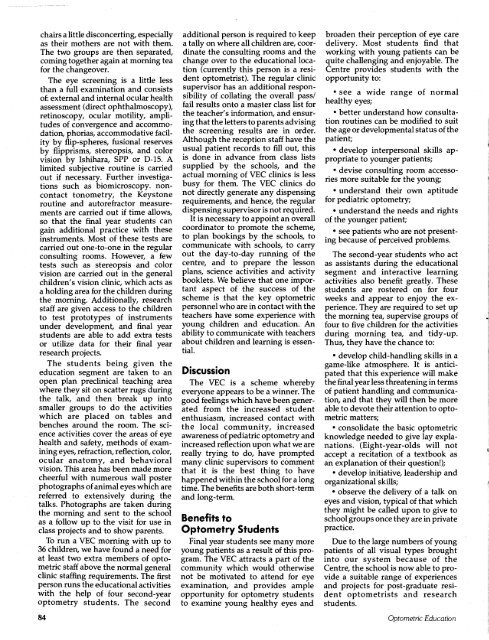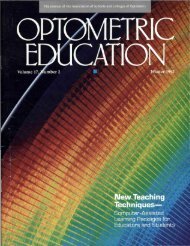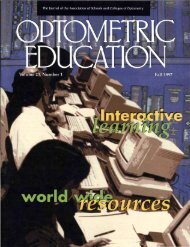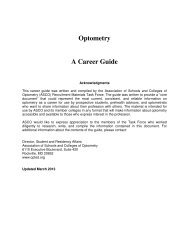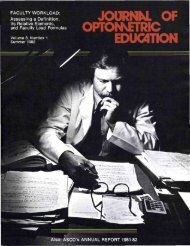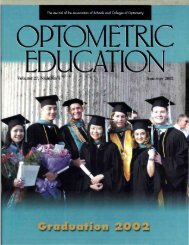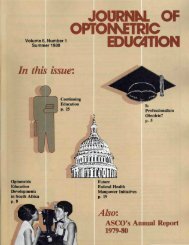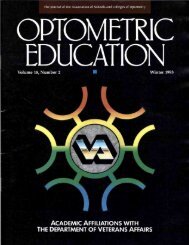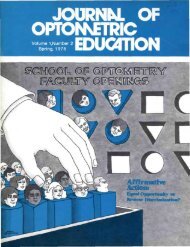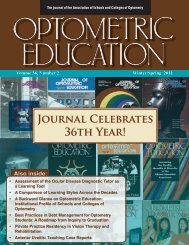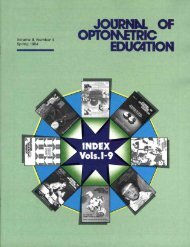Spring 1992, Volume 17, Number 3 - Association of Schools and ...
Spring 1992, Volume 17, Number 3 - Association of Schools and ...
Spring 1992, Volume 17, Number 3 - Association of Schools and ...
Create successful ePaper yourself
Turn your PDF publications into a flip-book with our unique Google optimized e-Paper software.
chairs a little disconcerting, especially<br />
as their mothers are not with them.<br />
The two groups are then separated,<br />
coming together again at morning tea<br />
for the changeover.<br />
The eye screening is a little less<br />
than a full examination <strong>and</strong> consists<br />
<strong>of</strong>: external <strong>and</strong> internal ocular health<br />
assessment (direct ophthalmoscopy),<br />
retinoscopy, ocular motility, amplitudes<br />
<strong>of</strong> convergence <strong>and</strong> accommodation,<br />
phorias, accommodative facility<br />
by flip-spheres, fusional reserves<br />
by flipprisms, stereopsis, <strong>and</strong> color<br />
vision by Ishihara, SPP or D-15. A<br />
limited subjective routine is carried<br />
out if necessary. Further investigations<br />
such as biomicroscopy, noncontact<br />
tonometry, the Keystone<br />
routine <strong>and</strong> autorefractor measurements<br />
are carried out if time allows,<br />
so that the final year students can<br />
gain additional practice with these<br />
instruments. Most <strong>of</strong> these tests are<br />
carried out one-to-one in the regular<br />
consulting rooms. However, a few<br />
tests such as stereopsis <strong>and</strong> color<br />
vision are carried out in the general<br />
children's vision clinic, which acts as<br />
a holding area for the children during<br />
the morning. Additionally, research<br />
staff are given access to the children<br />
to test prototypes <strong>of</strong> instruments<br />
under development, <strong>and</strong> final year<br />
students are able to add extra tests<br />
or utilize data for their final year<br />
research projects.<br />
The students being given the<br />
education segment are taken to an<br />
open plan preclinical teaching area<br />
where they sit on scatter rugs during<br />
the talk, <strong>and</strong> then break up into<br />
smaller groups to do the activities<br />
which are placed on tables <strong>and</strong><br />
benches around the room. The science<br />
activities cover the areas <strong>of</strong> eye<br />
health <strong>and</strong> safety, methods <strong>of</strong> examining<br />
eyes, refraction, reflection, color,<br />
ocular anatomy, <strong>and</strong> behavioral<br />
vision. This area has been made more<br />
cheerful with numerous wall poster<br />
photographs <strong>of</strong> animal eyes which are<br />
referred to extensively during the<br />
talks. Photographs are taken during<br />
the morning <strong>and</strong> sent to the school<br />
as a follow up to the visit for use in<br />
class projects <strong>and</strong> to show parents.<br />
To run a VEC morning with up to<br />
36 children, we have found a need for<br />
at least two extra members <strong>of</strong> optometric<br />
staff above the normal general<br />
clinic staffing requirements. The first<br />
person runs the educational activities<br />
with the help <strong>of</strong> four second-year<br />
optometry students. The second<br />
additional person is required to keep<br />
a tally on where all children are, coordinate<br />
the consulting rooms <strong>and</strong> the<br />
change over to the educational location<br />
(currently this person is a resident<br />
optometrist). The regular clinic<br />
supervisor has an additional responsibility<br />
<strong>of</strong> collating the overall pass/<br />
fail results onto a master class list for<br />
the teacher's information, <strong>and</strong> ensuring<br />
that the letters to parents advising<br />
the screening results are in order.<br />
Although the reception staff have the<br />
usual patient records to fill out, this<br />
is done in advance from class lists<br />
supplied by the schools, <strong>and</strong> the<br />
actual morning <strong>of</strong> VEC clinics is less<br />
busy for them. The VEC clinics do<br />
not directly generate any dispensing<br />
requirements, <strong>and</strong> hence, the regular<br />
dispensing supervisor is not required.<br />
It is necessary to appoint an overall<br />
coordinator to promote the scheme,<br />
to plan bookings by the schools, to<br />
communicate with schools, to carry<br />
out the day-to-day running <strong>of</strong> the<br />
centre, <strong>and</strong> to prepare the lesson<br />
plans, science activities <strong>and</strong> activity<br />
booklets. We believe that one important<br />
aspect <strong>of</strong> the success <strong>of</strong> the<br />
scheme is that the key optometric<br />
personnel who are in contact with the<br />
teachers have some experience with<br />
young children <strong>and</strong> education. An<br />
ability to communicate with teachers<br />
about children <strong>and</strong> learning is essential.<br />
Discussion<br />
The VEC is a scheme whereby<br />
everyone appears to be a winner. The<br />
good feelings which have been generated<br />
from the increased student<br />
enthusiasm, increased contact with<br />
the local community, increased<br />
awareness <strong>of</strong> pediatric optometry <strong>and</strong><br />
increased reflection upon what we are<br />
really trying to do, have prompted<br />
many clinic supervisors to comment<br />
that it is the best thing to have<br />
happened within the school for a long<br />
time. The benefits are both short-term<br />
<strong>and</strong> long-term.<br />
Benefits to<br />
Optometry Students<br />
Final year students see many more<br />
young patients as a result <strong>of</strong> this program.<br />
The VEC attracts a part <strong>of</strong> the<br />
community which would otherwise<br />
not be motivated to attend for eye<br />
examination, <strong>and</strong> provides ample<br />
opportunity for optometry students<br />
to examine young healthy eyes <strong>and</strong><br />
broaden their perception <strong>of</strong> eye care<br />
delivery. Most students find that<br />
working with young patients can be<br />
quite challenging <strong>and</strong> enjoyable. The<br />
Centre provides students with the<br />
opportunity to:<br />
• see a wide range <strong>of</strong> normal<br />
healthy eyes;<br />
• better underst<strong>and</strong> how consultation<br />
routines can be modified to suit<br />
the age or developmental status <strong>of</strong> the<br />
patient;<br />
• develop interpersonal skills appropriate<br />
to younger patients;<br />
• devise consulting room accessories<br />
more suitable for the young;<br />
• underst<strong>and</strong> their own aptitude<br />
for pediatric optometry;<br />
• underst<strong>and</strong> the needs <strong>and</strong> rights<br />
<strong>of</strong> the younger patient;<br />
• see patients who are not presenting<br />
because <strong>of</strong> perceived problems.<br />
The second-year students who act<br />
as assistants during the educational<br />
segment <strong>and</strong> interactive learning<br />
activities also benefit greatly. These<br />
students are rostered on for four<br />
weeks <strong>and</strong> appear to enjoy the experience.<br />
They are required to set up<br />
the morning tea, supervise groups <strong>of</strong><br />
four to five children for the activities<br />
during morning tea, <strong>and</strong> tidy-up.<br />
Thus, they have the chance to:<br />
• develop child-h<strong>and</strong>ling skills in a<br />
game-like atmosphere. It is anticipated<br />
that this experience will make<br />
the final year less threatening in terms<br />
<strong>of</strong> patient h<strong>and</strong>ling <strong>and</strong> communication,<br />
<strong>and</strong> that they will then be more<br />
able to devote their attention to optometric<br />
matters;<br />
• consolidate the basic optometric<br />
knowledge needed to give lay explanations.<br />
(Eight-year-olds will not<br />
accept a recitation <strong>of</strong> a textbook as<br />
an explanation <strong>of</strong> their question!);<br />
• develop initiative, leadership <strong>and</strong><br />
organizational skills;<br />
• observe the delivery <strong>of</strong> a talk on<br />
eyes <strong>and</strong> vision, typical <strong>of</strong> that which<br />
they might be called upon to give to<br />
school groups once they are in private<br />
practice.<br />
Due to the large numbers <strong>of</strong> young<br />
patients <strong>of</strong> all visual types brought<br />
into our system because <strong>of</strong> the<br />
Centre, the school is now able to provide<br />
a suitable range <strong>of</strong> experiences<br />
<strong>and</strong> projects for post-graduate resident<br />
optometrists <strong>and</strong> research<br />
students.<br />
84 Optometric Education


